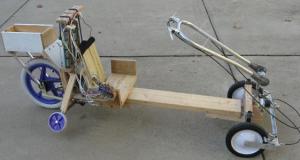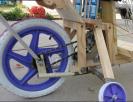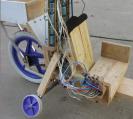| Owner | Ellis Madsen |
|---|---|
| Owner's Other EVs | Brico v2.0 Hybrid Powered bicycle |
| Location | Louisville, Kentucky United States map |
| | |
| Vehicle | 2008 13" wheel child's bike, golf cart wheels, bicycle caliper brakes, pine, oak and aluminum strut frame. No welding done; machine bolts only. I used only a power drill and manual hack saw. |
| Motor | 250W 24V with reduction gear to a bicycle chain sp Permanent Magnet DC from www.electricscooterparts.com |
| Drivetrain | bicycle chain with hand-made tensioner |
| Controller | hand-made four speed at 0, 12, 18 and 24 volts four battery modules of 6V each (5 batteries) are wired in series, selectable for 0V, 12V (2 modules), 18V (3 modules) and 24V (4 modules). Contacters are made from individual bicycle chain links mounted on an oak frame. This yields three forwards speeds. |
| Batteries | 20 Powerizer, 1.20 Volt, Nickel-Metal Hydride 10000 mA D cells in a handmade holder using 14 gauge wire. From www.batteryspace.com |
| System Voltage | 24 Volts |
| Charger | The four battery modules have connectors used for charging or for operation. The module order is changed at estimated half way point of a trip to equalize somewhat the amount of discharge from each module. |
| Heater | a heavy coat |
| DC/DC Converter | two 6V chargers from a 12VDC hand made modules from batteryspace |
| Instrumentation | none |
| Top Speed | 6 MPH ( 9 KPH) estimated |
| Acceleration | poor |
| Range | 5 Miles ( 8 Kilometers) estimated |
| Watt Hours/Mile | 250W/24V = 10.4A, but peak acceleration does not blow the recommended 30A fuze. |
| Seating Capacity | 1 adult |
| Curb Weight | 58 Pounds (26 Kilograms) |
| Tires | bicycle tube-type drive and solid "little red" wagon type. |
| Conversion Time | 3 months, not counting the prototypes. The hardest part were the fitting for the bicycle caliper brakes and hand made steering system. |
| Conversion Cost | US$175. |
| Additional Features | head light and a small cargo box. |
| This vehicle qualifies as an electric moped in Kentucky. it is very low to the ground and needs the "training wheels" during tight turns, which are a bit "exciting." It was made essentially as a demonstrator for the sequential switch I designed and built. The switch works very well. The demonstration was done in order to show how an efficient controller could be used that doesn't waste energy in the less-than-total voltage positions. It also shows that the sequence of the battery modules can be changed to equalize (somewhat) the discharge of the different modules. This was done manually in this case, but optimally it would be done automatically by switching the module order according to various rules, measurements of discharge, running time, etc. | |
Copyright © 1997-2025 by Mike Chancey



